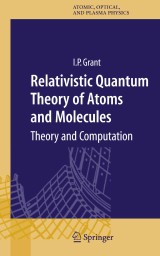Details

Relativistic Quantum Theory of Atoms and Molecules
Theory and ComputationSpringer Series on Atomic, Optical, and Plasma Physics, Band 40
|
309,23 € |
|
| Verlag: | Springer |
| Format: | |
| Veröffentl.: | 15.04.2007 |
| ISBN/EAN: | 9780387350691 |
| Sprache: | englisch |
| Anzahl Seiten: | 800 |
Dieses eBook enthält ein Wasserzeichen.
Beschreibungen
<P>Relativistic quantum electrodynamics, which describes the electromagneticinteractions of electrons and atomic nuclei, provides the basis for modeling the electronic structure of atoms, molecules and solids and of their interactions with photons and other projectiles. The theory underlying the widely used GRASP relativistic atomic structure program, the DARC electron-atom scattering code and the new BERTHA relativistic molecular structure program is presented in depth, together with computational aspects relevant to practical calculations. Along with an understanding of the physics and mathematics, the reader will gain some idea of how to use these programs to predict energy levels, ionization energies, electron affinities, transition probabilities, hyperfine effects and other properties of atoms and molecules.</P>
Relativity in atomic and molecular physics.- Relativity in atomic and molecular physics.- Foundations.- Relativistic wave equations for free particles.- The Dirac Equation.- Quantum electrodynamics.- Computational atomic and molecular structure.- Analysis and approximation of Dirac Hamiltonians.- Complex atoms.- Computation of atomic structures.- Computation of atomic properties.- Continuum processes in many-electron atoms.- Molecular structure methods.- Relativistic calculation of molecular properties.- Frequently used formulae and data.- Frequently used formulae and data.- Supplementary mathematics.- Supplementary mathematics.
<p>Professor Grant first became aware of the need to develop a relativistic theory of atomic and molecular structure some 50 years ago in connection with X-ray absorption by heavy metals. In a 1961 paper, he showed that the Dirac-Hartree-Fock equations for atoms could be written in a simple form which has been used in all subsequent atomic calculations. This early work was generalized to permit more accurate multi-configurational calculations in the next two decades, implemented in the widely used GRASP code for relativistic modeling of electronic wavefunctions, energy levels and radiative transition probabilities of spectral lines. The DARC code, an extension of GRASP which is designed to calculate cross sections for atom/ion collisions with low-energy electrons or photons, was developed mainly in the 1980s and is now becoming more relevant for applications involving target atoms of higher atomic number. The BERTHA code is the first relativistic molecular structure code designed to take advantage of the internal structure of Dirac four-component spinors; its speed and accuracy are now beginning to be appreciated and utilized effectively by quantum chemists. The book is designed for all those who would like to know more about the mathematics and physics of relativistic atomic and molecular theory and who wish to use the computational machinery now available to solve problems in atomic and molecular physics and their applications. </p><p><p>Professor Grant was elected a Fellow of the Royal Society of London in 1992.</p>
<P>This book presents a unified approach to modern relativistic theory of the electronic structure of atoms and molecules which will provide experimental and theoretical scientists and graduate students with a range of powerful computational tools for a growing range of physical, chemical, technological and biochemical applications. Starting from its foundations in quantum electrodynamics, the book contains a careful account of relativistic atomic and molecular structure based on Dirac's relativistic Hamiltonian, and the numerical algorithms implemented by modern computer programs. The relativistic atomic structure code GRASP, which can compute atomic energy levels, radiative transition rates and other atomic properties using the multiconfigurational Dirac-Hartree-Fock or relativistic configuration interaction methods, is reviewed along with the relativistic R-matrix code DARC, which is used for the high precision modelling of the interactions of atoms and ions with photons and electrons. The recently developed BERTHA relativistic molecular structure code, the first to exploit fully the symmetry properties of Dirac 4-component spinors, provides a new resource for studying the properties of molecules, atomic clusters and other materials, especially those containing heavy elements for which a relativistic model is essential.</P>
An up-to-date account of relativistic quantum theory of atoms and molecules and how to apply it to atomic and molecular physics A clear and comprehensive exposition of mathematical, algorithmic and computational methods emphasizing the physical principles on which they are based. Practical applications to atomic structure using the GRASP program Practical applications to electron and photon interactions with atoms and ions using the DARC program Practical applications to molecular electronic structure using the BERTHA program

















